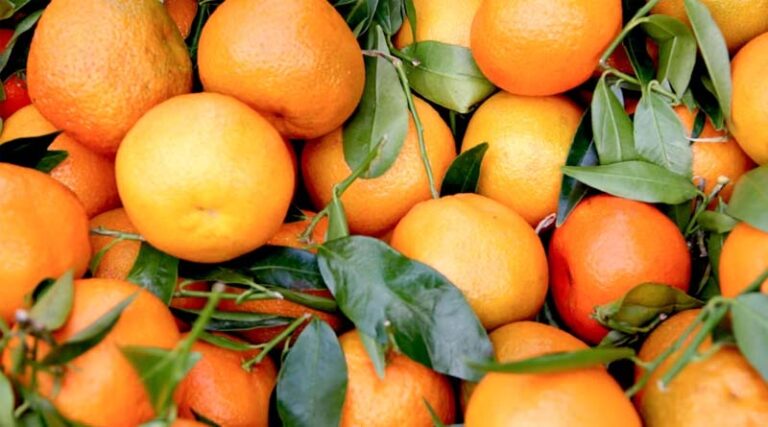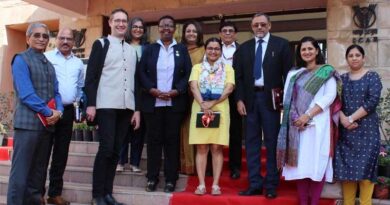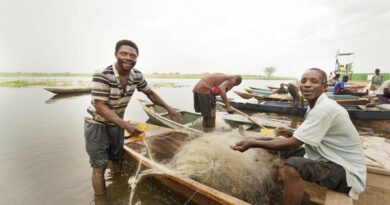
Improving Fruit Yield in Daisy Mandarin (Citrus Reticulata) by Foliar Application of Manganese and Iron
Ms. Bindia Suthar, Dr. Navdeep Singh, Mr. Gurdeep Singh, Dr. M.K. Kaul – Department of Horticulture, Faculty of Agriculture, Guru Kashi University, Talwandi Sabo (Punjab)
22 July 2025, New Delhi: In a study at Guru Kashi University, Talwandi Sabo, Punjab, evaluated the effects of foliar-applied manganese (Mn) and iron (Fe) on Daisy mandarin (Citrus reticulata) fruit characteristics and quality in a six-year-old orchard budded on Jatti Khatti (Citrus jambhiri Lush) rootstock. Using a Randomised Block Design, treatments included manganese sulphate (0.1, 0.2%, 0.3%) and ferrous sulphate (0.1, 0.2%, 0.3%) applied alone or in combination, with sixteen treatments, four replications, and sixty-four treatment combinations. The combination of 0.3% MnSO₄ + 0.3% FeSO₄ maximized fruit weight (156.87 g), fruit number (480.5), and yield (75.37 kg/plant).
Introduction
Citrus fruits are a cornerstone of global horticulture, with over 150 million metric tons produced annually across 10.2 million hectares, led by China, Brazil, India, and Mexico (FAO, 2023). In India, citrus cultivation covers 1.086 million hectares, yielding 14.26 million tons, with mandarins contributing 6.35 million tons in 2023 (Keelery, 2023). Punjab, a key region, cultivates 52,836 hectares of citrus, primarily Kinnow mandarins, with a productivity of 42.4 tons/ha.
Daisy mandarin (Citrus reticulata), a hybrid of Fortune and Fremont mandarins, is valued for its vibrant orange rind, early maturity, and balanced flavor, making it a premium cultivar (Gill et al., 2017). Micronutrients like iron (Fe) and manganese (Mn) are critical for citrus health. Iron supports chlorophyll synthesis and photosynthesis, while manganese aids enzymatic processes (Sharma et al., 2024; Tariq et al., 2024). Deficiencies can reduce fruit size and yield due to impaired photosynthesis or chlorosis. Foliar application of micronutrients has shown promise in enhancing fruit quality and yield (Kaur et al., 2024; El-Boray et al., 2020)
This study evaluates the effects of foliar-applied Mn and Fe on Daisy mandarin fruit quality and yield in Punjab, hypothesizing that optimized combinations will improve productivity.
Materials and Methods
The study was conducted in 2024 at Guru Kashi University, Talwandi Sabo, Punjab, India, characterized by a subtropical climate. Sixty-four healthy, six-year-old Daisy mandarin (Citrus reticulata) trees, budded on Jatti Khatti (Citrus jambhiri Lush) rootstock, were selected for their uniformity. The experiment employed a Randomized Block Design (RBD) Treatments comprised a water-spray control, and other treatment combinations: 0.1% MnSO₄ + 0.1% FeSO₄, 0.1% MnSO₄ + 0.2% FeSO₄, 0.1% MnSO₄ + 0.3% FeSO₄, 0.2% MnSO₄ + 0.1% FeSO₄, 0.2% MnSO₄ + 0.2% FeSO₄, 0.2% MnSO₄ + 0.3% FeSO₄, 0.3% MnSO₄ + 0.1% FeSO₄, 0.3% MnSO₄ + 0.2% FeSO₄, and 0.3% MnSO₄ + 0.3% FeSO₄. Foliar sprays were applied twice during the growing season using a high-pressure sprayer for full canopy coverage.
Fruit weight (g), number of fruits per tree, and yield (kg/plant) were measured at full maturity by harvesting and weighing all fruits in a single picking. Data were analyzed statistically per Gomez and Gomez (1983).
Results and Discussion
Fruit Weight (g): Foliar application of Mn and Fe significantly enhanced Daisy mandarin fruit characteristics (Table 1). Treatment T15 (0.3% MnSO₄ + 0.3% FeSO₄) produced the highest fruit weight (156.87 g), followed by T14 (0.3% MnSO₄ + 0.2% FeSO₄) at 153.75 g, which were statistically similar (p < 0.05). These results align with (Pawar et al., 2019), who noted that higher micronutrient concentrations improve fruit growth by enhancing photosynthesis and nutrient uptake.
Average Number of Fruits per Tree: The average number of fruits per tree was highest in T15 (480.5 fruits), closely followed by (T14) 0.3% MnSO₄ + 0.2% FeSO₄ (474.75 fruits). Yield per plant peaked in (T15) 0.3% MnSO₄ + 0.3% FeSO₄ at 75.37 kg/tree, with (T14) 0.3% MnSO₄ + 0.2% FeSO₄ yielding 72.99 kg/tree, nearly equivalent. These outcomes reflect enhanced tree vigor and photosynthetic efficiency, as reported by Sidhu (1988). Combined Mn and Fe applications likely optimized enzymatic activity and chlorophyll synthesis, boosting fruit set and retention (Tariq et al., 2024).
Yield per plant (Kg): Fruit yield is highest in (T15) 0.3% MnSO₄ + 0.3% FeSO₄ (75.37 kg/tree), with (T14) 0.3% MnSO₄ + 0.2% FeSO₄ (72.99 kg/tree) nearly equivalent. These results are as reported by Sidhu (1988), indicating that nutrient treatments enhance tree vigour, photosynthesis and boosts yield (Pawar et al., 2019).
4.1. Table 1. Effect of Different treatments and their combinations on Fruit weight, Average number of fruits per tree and Fruit Yield of Daisy mandarin
| Treatments | Fruit Weight in g | Average number of fruits per tree | Yield per plant (kg/tree) |
| T0 Control | 106.62 | 373.50 | 39.82 |
| T1 (0.1% Manganese sulphate) | 131.37 | 380.50 | 49.98 |
| T2 (0.2% Manganese sulphate) | 131.62 | 386.75 | 50.90 |
| T3 (0.3% Manganese sulphate) | 131.62 | 392.50 | 51.66 |
| T4 (0.1% Ferrous sulphate) | 133.25 | 399.00 | 53.16 |
| T5 (0.2% Ferrous sulphate) | 137.50 | 407.50 | 56.03 |
| T6 (0.3% Ferrous sulphate) | 139.12 | 415.25 | 57.76 |
| T7 (0.1% Manganese sulphate + 0.1% Ferrous sulphate) | 139.25 | 422.00 | 58.76 |
| T8 (0.1% Manganese sulphate + 0.2% Ferrous sulphate) | 140.12 | 429.75 | 60.21 |
| T9 (0.1% Manganese sulphate + 0.3% Ferrous sulphate) | 141.00 | 438.00 | 61.75 |
| T10 (0.2% Manganese sulphate + 0.1% Ferrous sulphate) | 142.00 | 444.75 | 63.15 |
| T11 (0.2% Manganese sulphate+ 0.2% Ferrous sulphate) | 145.37 | 451.25 | 65.59 |
| T12 (0.2% Manganese sulphate + 0.3% Ferrous sulphate) | 148.37 | 459.75 | 68.21 |
| T13 (0.3% Manganese sulphate + 0.1% Ferrous sulphate) | 153.00 | 466.75 | 71.41 |
| T14 (0.3% Manganese sulphate +0.2% Ferrous sulphate) | 153.75 | 474.75 | 72.99 |
| T15 (0.3% Manganese sulphate +0.3% Ferrous sulphate) | 156.87 | 480.50 | 75.37 |
| C.D. at 5% | 2.542 | 1.736 | 15.962 |
Conclusion
Foliar application of 0.3% manganese sulfate (MnSO₄) combined with 0.3% ferrous sulfate (FeSO₄), referred to as Treatment T15, markedly improved Daisy mandarin fruit characteristics, achieving an average fruit weight of 156.87 g, a fruit count of 480.5 per tree, and a yield of 75.37 kg per tree. This approach proved highly effective for enhancing citrus productivity in the subtropical climate of Punjab by leveraging the synergistic benefits of manganese and iron, which enhance photosynthesis, enzymatic functions, and fruit set, thereby mitigating common micronutrient deficiencies that limit citrus growth. For the citrus industry, this method offers a practical, scalable, and cost-efficient way to elevate both fruit quality and yield in Daisy mandarin orchards, especially those on Jatti Khatti rootstock. Key insights include the efficacy of the 0.3% MnSO₄ + 0.3% FeSO₄ combination for optimizing fruit size and yield, the advantage of foliar sprays for rapid nutrient absorption, and the opportunity for sustainable production through better resource utilization and improved economic outcomes. Citrus growers are advised to adopt this strategy, ensuring precise application timing and thorough canopy coverage to replicate these results. Future studies could investigate the long-term impacts and adaptability of this approach across diverse citrus varieties and soil conditions.
References
- Kaur, N., et al. (2024a). Daisy mandarin: Agronomic and nutritional traits. HortScience, 59(6), 789–797.
- Sharma, R., et al. (2024). Nutritional benefits of citrus flavonoids. Journal of Food Biochemistry, 46(1), e13987.
- Tariq, M., et al. (2024). Micronutrient management in citrus crops. Agricultural Reviews, 39(2), 87–95.
- El-Boray, M. S., et al. (2020). Impact of foliar application of micronutrients on yield and quality of Valencia orange. Scientia Horticulturae, 262, 109053.
- Razzaq, K., et al. (2021). Effect of foliar-applied iron and manganese on citrus fruit quality under semi-arid conditions. Journal of Plant Nutrition, 44(8), 1152–1163.
- Singh, A., et al. (2022). Foliar nutrient management for improving yield and quality of Kinnow mandarin in Punjab. Indian Journal of Agricultural Sciences, 92(3), 345–350.
- Ullah, S., et al. (2023). Role of micronutrients in enhancing fruit set and yield in citrus orchards. Journal of Horticultural Science & Biotechnology, 98(4), 512–520.
Also Read: Sona Machinery Expands Its Presence in Nepal With a Turnkey Rice Mill and Parboiling Dryer Plant
📢 If You’re in Agriculture, Make Sure the Right People Hear Your Story.
From product launches to strategic announcements, Global Agriculture offers unmatched visibility across international agri-business markets. Connect with us at pr@global-agriculture.com to explore editorial and advertising opportunities that reach the right audience, worldwide.






